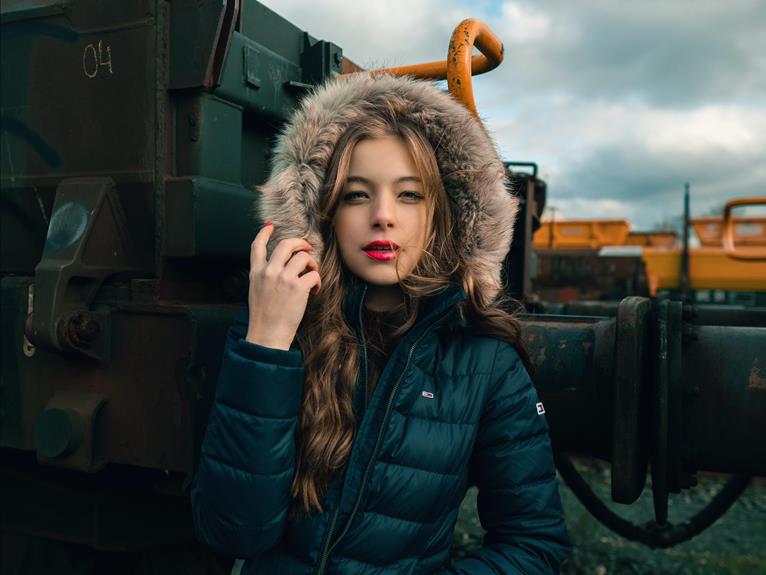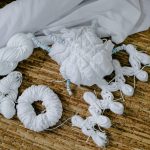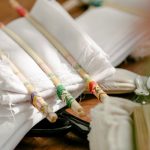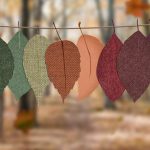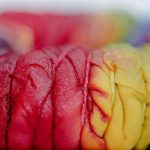Transform your jacket into a vibrant expression of individuality with 5 easy ways to dye it fast. Mastering these techniques will elevate your style game and give your jacket a fresh, personalized look.
From fabric dye spray to the dip dyeing technique, you'll have the tools to create a unique and eye-catching garment. Whether you're drawn to tie-dye or color blocking with fabric paint, these methods offer a fast and effective way to revamp your jacket.
Embrace the art of ice dyeing for a stunning, one-of-a-kind result. With these simple yet powerful methods, you'll be able to dye your jacket fast and achieve a professional-looking finish.
Key Takeaways
- Fabric dye spray is an instant and convenient way to color your jacket quickly.
- Dip dyeing technique can create a gradient effect on your jacket by using complementary dye colors.
- Tie-dye method allows you to achieve a vibrant and psychedelic look on your jacket by twisting, folding, and tying the fabric before dyeing.
- Color blocking with fabric paint is a technique that involves selecting contrasting or complementary colors and using masking tape or stencils for clean shapes on your jacket.
Using Fabric Dye Spray
If you frequently find yourself in need of a quick jacket dye job, fabric dye spray can be your go-to solution for a fast and easy transformation. When it comes to achieving quick results, fabric dye spray is the way to go. Unlike traditional liquid dyes, fabric dye spray allows for instant color application, cutting down the dyeing process significantly. This means that you can have a freshly dyed jacket in no time, perfect for those last-minute outfit changes or revamping old clothing for a new look.
One of the key advantages of using fabric dye spray is the minimal mess it creates. Traditional dyeing methods often involve buckets of dye and stirring, which can lead to accidental spills and splatters. With fabric dye spray, you have better control over where the dye goes, reducing the chances of creating a mess. This makes it an ideal choice for those who want to avoid the hassle of cleaning up after a dyeing session.
Dip Dyeing Technique
To achieve a quick and stylish jacket transformation, consider utilizing the dip dyeing technique.
Dip dyeing allows you to create a beautiful gradient effect on your jacket, giving it a unique and personalized look.
Here are some dip dyeing tips to help you master this technique:
- Choose the best dye colors: Opt for colors that complement each other well to achieve a visually appealing gradient. Popular choices include indigo and white for a classic denim look, or pastel shades for a softer, more ethereal effect.
- Pre-wash your jacket: Ensure your jacket is clean before dyeing to allow the dye to adhere evenly to the fabric.
- Use the right dye concentration: Follow the instructions on the dye packaging to achieve the desired color intensity. Experiment with different concentrations to create variations in the gradient.
- Dip the jacket strategically: Dip the jacket into the dye bath slowly and steadily, allowing the dye to penetrate the fabric gradually for a smooth transition of colors.
- Rinse and dry carefully: After dyeing, rinse the jacket thoroughly to remove excess dye, then carefully dry it to set the colors and prevent bleeding.
Tie-Dye Method
You can achieve a vibrant and psychedelic look for your jacket by using the tie-dye method. Tie-dye is a popular technique that involves twisting, folding, and tying fabric before applying dye. There are various tie-dye patterns you can experiment with, such as spiral, bullseye, or crumple.
When selecting fabric color combinations for tie-dye, consider complementary or contrasting colors to create visually striking designs. For example, using blue and green together can evoke a calming and natural feel, while combining red and yellow can result in a bold and energetic look.
To create tie-dye patterns, start by dampening the fabric and laying it flat. Then, pinch, fold, or twist the fabric into the desired pattern and secure it with rubber bands. Next, apply the dye to the fabric, ensuring complete coverage of the sections.
Allow the dye to set according to the instructions before rinsing and washing the fabric. Remember to wear gloves and work in a well-ventilated area when dyeing to avoid staining your hands and inhaling fumes.
With the tie-dye method, you can personalize your jacket with unique patterns and color combinations, showcasing your individual style.
Color Blocking With Fabric Paint
When considering color blocking with fabric paint, start by selecting contrasting or complementary colors that will create visually striking sections on your jacket. To achieve mastery in this technique, consider the following fabric painting techniques and color blending ideas:
- Masking: Use masking tape or stencils to create clean, geometric shapes on your jacket. This technique allows for precise color blocking and sharp lines.
- Layering: Experiment with layering different colors to create depth and dimension in your color-blocked sections. Start with lighter colors as a base and layer darker shades on top for a dynamic effect.
- Gradient Blending: Blend two or more colors together to create a smooth transition between color-blocked sections. This technique adds a unique and artistic touch to your jacket.
- Contrast Piping: Add contrast piping between color-blocked sections to create a defined separation and add a polished finish to your design.
- Texture Play: Explore different fabric painting techniques such as stippling, splattering, or sponging to add texture to your color-blocked sections, making them visually interesting and tactile.
Ice Dyeing Process
Explore the mesmerizing technique of ice dyeing to create stunning and unique patterns on your jacket using vibrant colors and a simple process. Ice dyeing is a quick and easy way to achieve beautiful, watercolor-like designs with minimal mess.
The process involves laying out your jacket on a rack, sprinkling powdered dye over ice that's been placed on top of the fabric, and allowing the melting ice to create intricate patterns as the dye seeps through the fabric. This method yields quick results, as the melting ice helps the dye to set rapidly, resulting in vibrant and dynamic designs.
The beauty of ice dyeing lies in its unpredictability, as the melting ice creates one-of-a-kind patterns every time. Once the ice has completely melted, the jacket can be rinsed and washed to reveal the stunning, multi-tonal design.
With minimal set-up and a relatively short processing time, ice dyeing is a fantastic way to add a pop of color and creativity to your jacket in no time.
Frequently Asked Questions
Can I Use Regular Spray Paint Instead of Fabric Dye Spray?
Yes, you can use regular spray paint for fabric dyeing, but it may not be as effective as fabric dye spray. Consider alternatives such as fabric dye specifically made for textiles for best results.
What Type of Fabric Works Best for the Dip Dyeing Technique?
For the dip dyeing technique, the best fabric is natural fibers like cotton, linen, or silk. They absorb colors well and provide a soft, durable finish. Consider fabric durability, color options, and your preferences when choosing.
Can I Use Food Coloring for the Tie-Dye Method Instead of Fabric Dye?
Yes, you can use food coloring for the tie-dye method, but it may not be as effective or long-lasting as fabric dye. For a quicker option, consider fabric dye spray or spray paint.
Is It Possible to Use Regular Acrylic Paint for Color Blocking Instead of Fabric Paint?
Yes, you can use regular acrylic paint for color blocking instead of fabric paint. It's a quick and easy alternative. Just make sure to properly prepare the fabric and use a fabric medium to help the paint adhere.
How Long Does the Fabric Need to Sit in the Ice Dyeing Process Before Rinsing It Out?
To achieve optimal color intensity in ice dyeing, let the fabric sit for 12-24 hours before rinsing. The longer it sits, the deeper the hues. Rinsing time impacts the final result, so experiment to find your desired effect.
- Does Chiffon Fabric Stink - July 15, 2025
- Does Chiffon Fabric Affect the Economy - July 15, 2025
- Does Cotton Fabric Have a Nap - July 15, 2025

